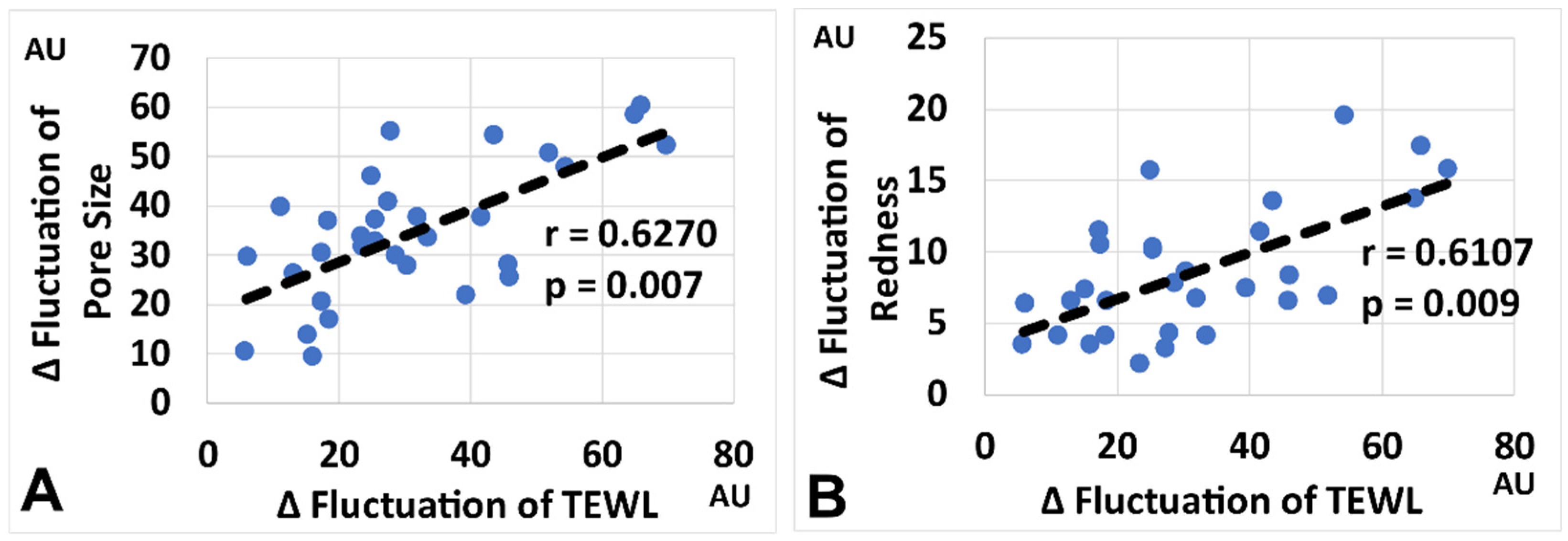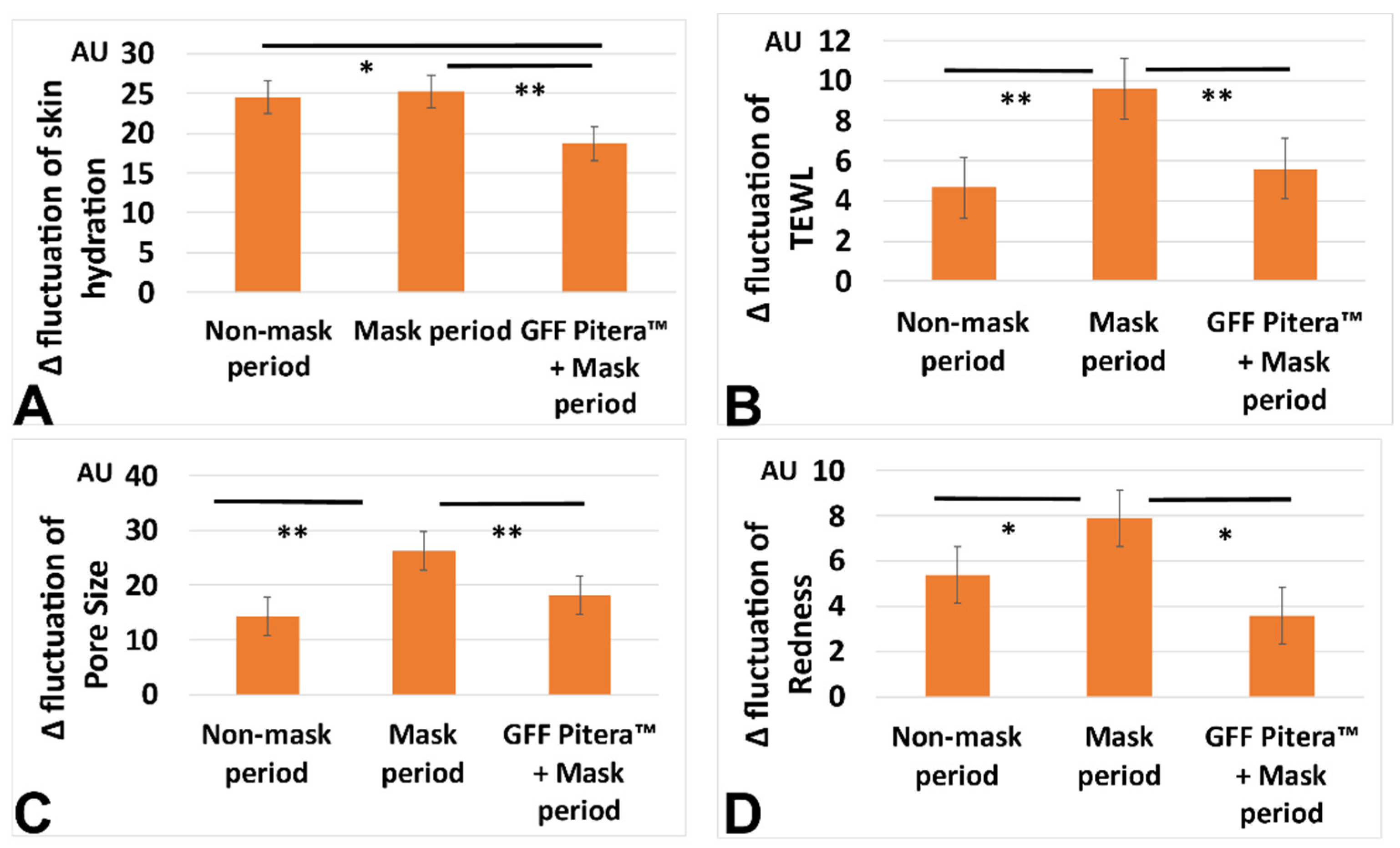Enhanced Fluctuations in Facial Pore Size, Redness, and TEWL Caused by Mask Usage Are Normalized by the Application of a Moisturizer
Abstract
:1. Introduction
2. Materials and Methods
2.1. Subjects and Study Protocol
2.2. Measurement of Pore Size, Redness, Skin Hydration, and TEWL
2.3. Statistical Analysis
3. Results
4. Discussion
Supplementary Materials
Author Contributions
Funding
Institutional Review Board Statement
Informed Consent Statement
Data Availability Statement
Acknowledgments
Conflicts of Interest
Ethical Statement
References
- Li, Y.; Wei, Z.; Zhang, J.; Li, R.; Li, H.; Cao, L.; Hou, L.; Zhang, W.; Chen, N.; Guo, K.; et al. Wearing masks to reduce the spread of respiratory viruses: A systematic evidence mapping. Ann. Transl. Med. 2021, 9, 811. [Google Scholar] [CrossRef] [PubMed]
- Barnawi, G.M.; Barnawi, A.M.; Samarkandy, S. The association of the prolonged use of personal protective equipment and face mask during COVID-19 pandemic with various dermatologic disease manifestations: A systematic review. Cureus 2021, 13, e16544. [Google Scholar] [CrossRef] [PubMed]
- Wilcha, R.J. Does wearing a face mask during the COVID-19 pandemic increase the incidence of dermatological conditions in health care workers? Narrative literature review. JMIR Dermatol. 2021, 4, e22789. [Google Scholar] [CrossRef] [PubMed]
- Park, S.J.; Han, H.S.; Shin, S.H.; Yoo, K.H.; Li, K.; Kim, B.J.; Seo, S.J.; Park, K.Y. Adverse skin reactions due to use of face masks: A prospective survey during the COVID-19 pandemic in Korea. J. Eur. Acad. Dermatol. Venereol. 2021, 35, e628–e630. [Google Scholar] [CrossRef]
- İnan Doğan, E.; Kaya, F. Dermatological findings in patients admitting to dermatology clinic after using face masks during COVID-19 pandemia: A new health problem. Dermatol. Ther. 2021, 34, e14934. [Google Scholar] [CrossRef]
- Spigariolo, C.B.; Giacalone, S.; Nazzaro, G. Maskne: The Epidemic within the pandemic: From diagnosis to therapy. J. Clin. Med. 2022, 11, 618. [Google Scholar] [CrossRef]
- Teo, W.L. Diagnostic and management considerations for “maskne” in the era of COVID-19. J. Am. Acad. Dermatol. 2021, 84, 520–521. [Google Scholar] [CrossRef]
- Kassamali, B.; Kus, K.J.B.; Min, M.S.; Cobos, G.A.; LaChance, A.H.; Mazori, D.R. Importance of nose wires in face masks: A reply to “Diagnostic and management considerations for “maskne” in the era of COVID-19”. J. Am. Acad. Dermatol. 2021, 85, e151–e152. [Google Scholar] [CrossRef]
- Branisteanu, D.E.; Toader, M.P.; Porumb, E.A.; Serban, I.L.; Pinzariu, A.C.; Branisteanu, C.I.; Vicovan, A.; Dimitriu, A.; Fartusnic, I.A.; Boda, D.; et al. Adult female acne: Clinical and therapeutic particularities (Review). Exp. Ther. Med. 2022, 23, 151. [Google Scholar] [CrossRef]
- Han, H.S.; Shin, S.H.; Park, J.W.; Li, K.; Kim, B.J.; Yoo, K.H. Changes in skin characteristics after using respiratory protective equipment (medical masks and respirators) in the COVID-19 pandemic among healthcare workers. Contact Dermat. 2021, 85, 225–232. [Google Scholar] [CrossRef]
- Hua, W.; Zuo, Y.; Wan, R.; Xiong, L.; Tang, J.; Zou, L.; Shu, X.; Li, L. Short-term skin reactions following use of N95 respirators and medical masks. Contact Dermat. 2020, 83, 115–121. [Google Scholar] [CrossRef] [PubMed]
- Kim, J.; Yoo, S.; Kwon, O.S.; Jeong, E.T.; Lim, J.M.; Park, S.G. Influence of quarantine mask use on skin characteristics: One of the changes in our life caused by the COVID-19 pandemic. Skin Res. Technol. 2021, 27, 599–606. [Google Scholar] [CrossRef] [PubMed]
- Park, S.R.; Han, J.; Yeon, Y.M.; Kang, N.Y.; Kim, E.; Suh, B.F. Long-term effects of face masks on skin characteristics during the COVID-19 pandemic. Skin Res. Technol. 2022, 28, 153–161. [Google Scholar] [CrossRef] [PubMed]
- Miyamoto, K.; Dissanayake, B.; Omotezako, T.; Takemura, M.; Tsuji, G.; Furue, M. Daily fluctuation of facial pore area, roughness and redness among young Japanese women; Beneficial effects of Galactomyces ferment filtrate containing antioxidative skin care formula. J. Clin. Med. 2021, 10, 2502. [Google Scholar] [CrossRef] [PubMed]
- Yosipovitch, G.; Xiong, G.L.; Haus, E.; Sackett-Lundeen, L.; Ashkenazi, I.; Maibach, H.I. Time-dependent variations of the skin barrier function in humans: Transepidermal water loss, stratum corneum hydration, skin surface pH, and skin temperature. J. Investig. Dermatol. 1998, 110, 20–23. [Google Scholar] [CrossRef] [Green Version]
- Furue, K.; Ito, T.; Tanaka, Y.; Yumine, A.; Hashimoto-Hachiya, A.; Takemura, M.; Murata, M.; Yamamura, K.; Tsuji, G.; Furue, M. Cyto/chemokine profile of in vitro scratched keratinocyte model: Implications of significant upregulation of CCL20, CXCL8 and IL36G in Koebner phenomenon. J. Dermatol. Sci. 2019, 94, 244–251. [Google Scholar] [CrossRef] [Green Version]
- Furue, K.; Ito, T.; Tanaka, Y.; Hashimoto-Hachiya, A.; Takemura, M.; Murata, M.; Kido-Nakahara, M.; Tsuji, G.; Nakahara, T.; Furue, M. The EGFR-ERK/JNK-CCL20 pathway in scratched keratinocytes may underpin Koebnerization in psoriasis patients. Int. J. Mol. Sci. 2020, 21, 434. [Google Scholar] [CrossRef] [Green Version]
- Furue, K.; Ito, T.; Tsuji, G.; Nakahara, T.; Furue, M. Scratch wound-induced CXCL8 upregulation is EGFR-dependent in keratinocytes. J. Dermatol. Sci. 2020, 99, 209–212. [Google Scholar] [CrossRef]
- Damiani, G.; Gironi, L.C.; Kridin, K.; Pacifico, A.; Buja, A.; Bragazzi, N.L.; Spalkowska, M.; Pigatto, P.D.M.; Santus, P. Mask-induced Koebner phenomenon and its clinical phenotypes: A multicenter, real-life study focusing on 873 dermatological consultations during COVID-19 pandemics. Dermatol. Ther. 2021, 34, e14823. [Google Scholar] [CrossRef]
- Sun, X.; Chen, L.; Shen, Z. Mask-induced Koebner phenomenon in an inverse psoriatic patient during COVID-19 pandemic. Contact Dermat. 2022, 86, 50–52. [Google Scholar] [CrossRef]
- Osborn, R.; Hakozaki, T.; Jarrold, B.; Mullins, L. Stimulation of skin hyaluronan by yeast-conditioned culture medium in vitro. J. Am. Acad. Dermatol. 2007, 56 (Suppl. 2), AB93. [Google Scholar]
- Takei, K.; Mitoma, C.; Hashimoto-Hachiya, A.; Takahara, M.; Tsuji, G.; Nakahara, T.; Furue, M. Galactomyces fermentation filtrate prevents T helper 2-mediated reduction of filaggrin in an aryl hydrocarbon receptor-dependent manner. Clin. Exp. Dermatol. 2015, 40, 786–793. [Google Scholar] [CrossRef] [PubMed]
- Hashimoto-Hachiya, A.; Tsuji, G.; Furue, M. Antioxidants cinnamaldehyde and Galactomyces fermentation filtrate downregulate senescence marker CDKN2A/p16INK4A via NRF2 activation in keratinocytes. J. Dermatol. Sci. 2019, 96, 53–56. [Google Scholar] [CrossRef] [PubMed] [Green Version]





| Intra-Day Average | No-Mask Baseline Period | Mask-Wearing Period | p Value |
|---|---|---|---|
| Skin hydration (AU) | 45.51 ± 3.2053 | 45.91 ± 4.1893 | 0.342 |
| TEWL (AU) | 44.93 ± 2.9413 | 45.62 ± 3.8747 | 0.285 |
| Pore size (AU) | 30.33 ± 4.1542 | 55.44 ± 7.8345 * | 0.015 |
| Redness (AU) | 63.26 ± 3.6485 | 63.37 ± 4.3198 | 0.687 |
| Intra-Day Δ Fluctuation | No-Mask Baseline Period | Mask-Wearing Period | p Value |
|---|---|---|---|
| Skin hydration (AU) | 24.53 ± 3.5821 | 25.23 ± 4.042 | 0.288 |
| TEWL (AU) | 4.67 ± 1.8295 | 9.63 ± 3.5148 * | 0.005 |
| Pore size (AU) | 14.34 ± 3.3655 | 26.24 ± 5.9189 * | 0.003 |
| Redness (AU) | 5.41 ± 2.6613 | 7.88 ± 3.8652 * | 0.026 |
Publisher’s Note: MDPI stays neutral with regard to jurisdictional claims in published maps and institutional affiliations. |
© 2022 by the authors. Licensee MDPI, Basel, Switzerland. This article is an open access article distributed under the terms and conditions of the Creative Commons Attribution (CC BY) license (https://creativecommons.org/licenses/by/4.0/).
Share and Cite
Miyamoto, K.; Munakata, Y.; Yan, X.; Tsuji, G.; Furue, M. Enhanced Fluctuations in Facial Pore Size, Redness, and TEWL Caused by Mask Usage Are Normalized by the Application of a Moisturizer. J. Clin. Med. 2022, 11, 2121. https://doi.org/10.3390/jcm11082121
Miyamoto K, Munakata Y, Yan X, Tsuji G, Furue M. Enhanced Fluctuations in Facial Pore Size, Redness, and TEWL Caused by Mask Usage Are Normalized by the Application of a Moisturizer. Journal of Clinical Medicine. 2022; 11(8):2121. https://doi.org/10.3390/jcm11082121
Chicago/Turabian StyleMiyamoto, Kukizo, Yoko Munakata, Xianghong Yan, Gaku Tsuji, and Masutaka Furue. 2022. "Enhanced Fluctuations in Facial Pore Size, Redness, and TEWL Caused by Mask Usage Are Normalized by the Application of a Moisturizer" Journal of Clinical Medicine 11, no. 8: 2121. https://doi.org/10.3390/jcm11082121
APA StyleMiyamoto, K., Munakata, Y., Yan, X., Tsuji, G., & Furue, M. (2022). Enhanced Fluctuations in Facial Pore Size, Redness, and TEWL Caused by Mask Usage Are Normalized by the Application of a Moisturizer. Journal of Clinical Medicine, 11(8), 2121. https://doi.org/10.3390/jcm11082121






